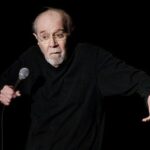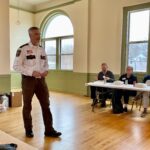FReeper Canteen ~ Hall of Heroes: Joseph Jacob Foss ~ 29 September 2025
Born on a farm near Sioux Falls, South Dakota, as the oldest son of Olouse and Mary Lacey Foss, Joe Foss grew up in a farmhouse without electricity. At the age of 12, he visited a local airfield in Renner to see Charles Lindbergh on tour with his aircraft, the Spirit of St. Louis. Four years later, he and his father paid $1 to attend a similar event.
In 1933, tragedy struck the Foss family when, during a storm, Joe’s father died after driving over a downed electrical cable and being electrocuted as he stepped out of his automobile. At just 17 years old, Joe dropped out of school to help his mother run the family farm. Farming was challenging due to persistent dust storms, which over the next two years damaged crops and livestock.
Inspired by watching a Marine Corps aerial team led by Capt. Foss worked at a service station to pay for books and college tuition, and in 1938, he began flight lessons from Roy Lanning at the Sioux Skyway Airfield, scraping together $65 to cover his instruction. His younger brother took over farm management, allowing Joe to return to school and graduate from Sioux Falls College.
While attending the University of South Dakota (USD), Foss and other like-minded students persuaded authorities to establish a Civil Aeronautics Authority flying course at the university. By graduation, he had accumulated 100 flight hours. To pay his way through university, Foss worked as a busboy. He joined the Sigma chapter of the Sigma Alpha Epsilon fraternity and excelled in sports, competing on the college boxing team, track team, and serving as a second-string guard on the football team.
Foss also served as a Private in the 147th Field Artillery, Sioux Falls, SD National Guard from 1937 to 1940.
—
### World War II Service and the Cactus Air Force
On October 9, Foss and his group were launched off the USS Copahee escort carrier and flew 350 miles north to Guadalcanal. The air group, code-named “Cactus,” was based at Henderson Field and became known as the Cactus Air Force. Their presence played a pivotal role in the Battle of Guadalcanal.
Foss quickly gained a reputation for aggressive, close-in fighter tactics and remarkable gunnery skills. On his first combat mission on October 13, he shot down a Japanese Mitsubishi Zero. Despite his own F4F Wildcat being heavily damaged and with a dead engine and multiple enemies pursuing him, he managed a near-perfect landing on the American-held runway at Guadalcanal.
Leading a flight of eight Wildcats, Foss’s group became known as “Foss’s Flying Circus,” split into two sections he nicknamed “Farm Boys” and “City Slickers.”
Conditions in the jungle were extreme, and in December 1942, Foss contracted malaria. He was sent to Sydney, Australia for rehabilitation, where he met British ace Clive “Killer” Caldwell and gave lectures on operational flying to newly arrived RAF pilots.
Returning to Guadalcanal on January 1, 1943, Foss resumed combat operations until February 9, 1943. Over three months of sustained combat, Foss’s Flying Circus shot down 72 Japanese aircraft, with 26 credited to Foss himself.
Upon matching the record of 26 kills held by America’s top World War I ace, Eddie Rickenbacker, Foss became America’s first “ace-of-aces” in World War II.
—
### Medal of Honor and War Bond Tour
Foss returned to the United States in March 1943. On May 18, 1943, he received the Medal of Honor from President Franklin Delano Roosevelt in a White House ceremony featured in *Life* magazine, with Foss appearing on its cover.
Following this, he participated in a war bond tour that extended into 1944, helping raise support and morale on the home front.
—
### Comparing Fighter Ace Scores
While Joe Foss is credited with 26 victories, other notable aces during the period include Gregory “Pappy” Boyington and Robert M. Hanson. Boyington’s wartime claims include victories scored with the American Volunteer Group (Flying Tigers) before rejoining the Marine Corps, with Marines crediting him with 28 victories overall, though the American Fighter Aces Association credits him with 24. Boyington ranks behind Foss (26) and Hanson (25) in terms of official kills.
—
### Post-War Air National Guard Service
In August 1945, Foss was released to inactive duty and opened the Joe Foss Flying Service in Sioux Falls, offering charter flights and flight instruction. The operation eventually grew to include 35 aircraft.
Later, with a friend, Foss owned a Packard car dealership in Sioux Falls. In October 1945, he appeared in Navy Day ceremonies in Iowa and was finally relieved from active duty in December 1945. He remained in the Marine Corps Reserve on inactive duty until 1947.
In 1946, Foss was appointed a lieutenant colonel in the South Dakota Air National Guard and tasked with forming the South Dakota Air National Guard. He became the commanding officer of the 175th Fighter-Interceptor Squadron and was actively involved in administration, flying, and even participated in their P-51 Mustang air demonstration team.
During the Korean War, Foss was called to active duty with the United States Air Force as a colonel and served as Director of Operations and Training for the Central Air Defense Command. He eventually rose to the rank of Brigadier General.
—
### Political Career
Campaigning from the cockpit of a light aircraft, Foss served two terms as a Republican representative in the South Dakota legislature. In 1955, at age 39, he became South Dakota’s youngest governor.
While governor, he accompanied a young Tom Brokaw—then a high school student and Governor of South Dakota American Legion Boys State—to New York City for a joint appearance on the television game show *Two for the Money*, which featured Foss due to his wartime celebrity.
In 1958, Foss sought a seat in the U.S. House of Representatives but was defeated by Democrat George Stanley McGovern during a difficult year for Republicans nationally.
Foss attempted a political comeback in 1962, running to succeed the late Senator Francis Case. He lost to Joseph H. Bottum, who filled out the term but later lost the general election to McGovern.
—
### Career in Professional Football and Television
After his political career, Foss briefly worked for Raven Industries before becoming the first Commissioner of the American Football League (AFL) in 1959. He oversaw the league’s early growth, negotiating significant television contracts, including a five-year, $10.6 million deal with ABC to broadcast AFL games.
Foss stepped down as commissioner in 1966, shortly before the historic AFL-NFL merger and the creation of the Super Bowl.
Between 1964 and 1967, Foss hosted ABC’s *The American Sportsman*, traveling worldwide on hunting and fishing expeditions. From 1967 to 1974, he produced and hosted his own syndicated outdoors TV series, *The Outdoorsman: Joe Foss*. In 1972, he also began a six-year stint as Director of Public Affairs for KLM Royal Dutch Airlines.
—
### National Rifle Association Leadership and Philanthropy
Starting in 1988, Foss served two consecutive one-year terms as president of the National Rifle Association (NRA). During this time, he maintained a rigorous speaking schedule, advocating conservative causes and defending gun owners’ rights. He was famously portrayed on the cover of *Time* magazine wearing his Stetson hat and holding a revolver.
Foss was deeply involved in philanthropic causes. Having a daughter with cerebral palsy, he served as president of the National Society of Crippled Children and Adults. He also supported the Easter Seals campaign, Campus Crusade for Christ, and programs for disadvantaged youth in Arizona.
In 2001, Foss and his second wife, Donna (“Didi”), founded The Joe Foss Institute, a nonprofit dedicated to promoting patriotism, public service, integrity, and appreciation for America’s freedoms. The Institute recruits military veterans to visit schools nationwide and engage with students. Foss himself frequently spoke to teenagers about service, responsibility, and commitment.
—
### Honors and Recognition
Foss coauthored or was the subject of three books: *Joe Foss: Flying Marine* (with Walter Simmons), *Top Guns* (with Matthew Brennan), and *A Proud American* by his wife Donna Wild Foss.
Tom Brokaw described Foss as having “a hero’s swagger but a winning smile to go with his plain talk and movie-star looks,” calling him “larger than life.”
Plans for a 1955 film about Foss’s life, *Brave Eagle*, starring his friend John Wayne, fell through in 1956 when Foss refused to allow the addition of a fictitious love story.
The award-winning television documentary *American Ace: The Joe Foss Story* was produced by South Dakota Public Broadcasting and first aired in 2006.
Foss also served as a former president and board chairman of the Air Force Association and as a Director of the United States Air Force Academy. In 2000, he acted as a consultant on the popular computer game *Combat Flight Simulator 2* by Microsoft.
—
### Later Years and Passing
On January 11, 2002, at age 86, Foss was detained by security at Phoenix Sky Harbor International Airport due to his pacemaker preventing metal detector screening. The search uncovered his Medal of Honor and related memorabilia, which airport personnel failed to recognize, leading to a national debate about post-9/11 airport security procedures.
In October 2002, Foss suffered a severe stroke caused by a cerebral aneurysm. He passed away three months later on January 1, 2003, never having regained consciousness.
Foss died in Scottsdale, Arizona, where he and his wife lived in later years. Vice President Dick Cheney, retired Colonel Oliver North, and South Dakota native and NBC News anchor Tom Brokaw attended his funeral. North delivered the eulogy, and actor Charlton Heston gave a tribute.
Foss was buried at Arlington National Cemetery on January 21, 2003. Family, friends, military personnel, and dignitaries also held a memorial service at Fort Myer.
—
### Memorials and Legacy
Several institutions and locations are named in Foss’s honor, including:
– Joe Foss Field Air National Guard Station in Sioux Falls, South Dakota
– Joe Foss Field at Sioux Falls Regional Airport
– Joe Foss High School in Sioux Falls
– The State Building in Pierre, South Dakota
A larger-than-life bronze statue of Foss stands in the lobby of the Sioux Falls Regional Airport, commemorating his legacy as a war hero, public servant, and patriot.
https://freerepublic.com/focus/f-news/4343184/posts








